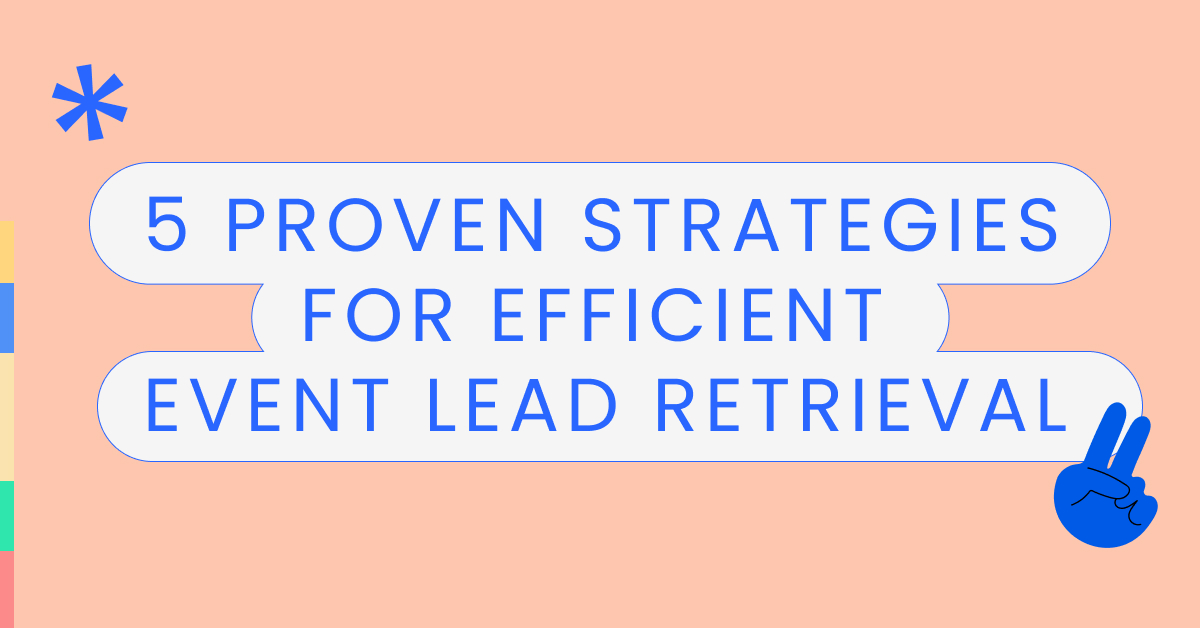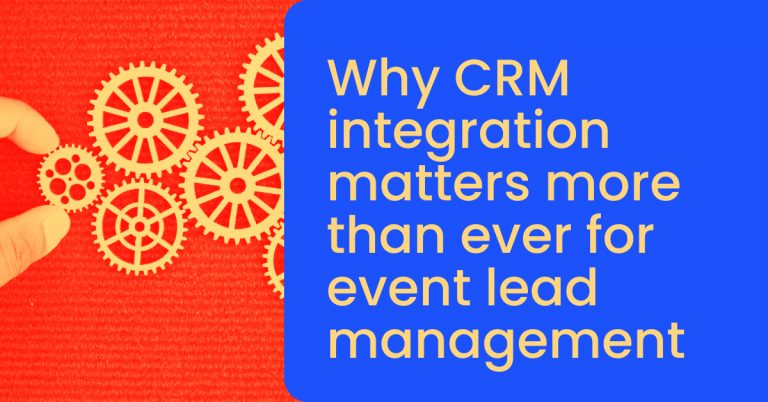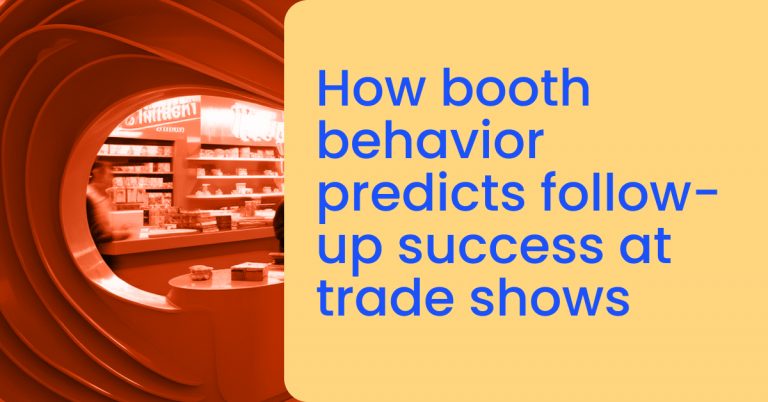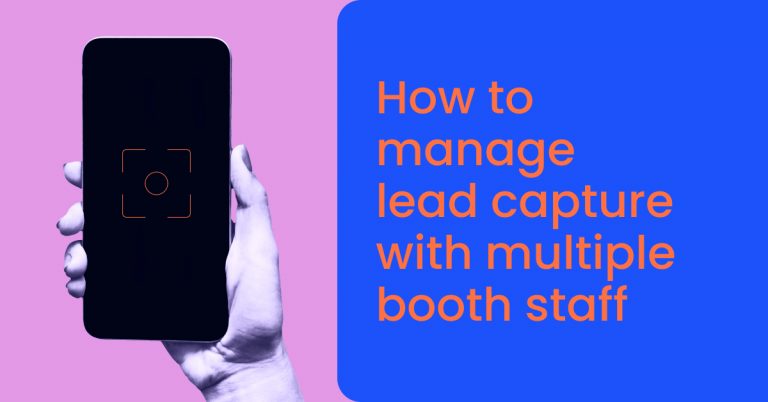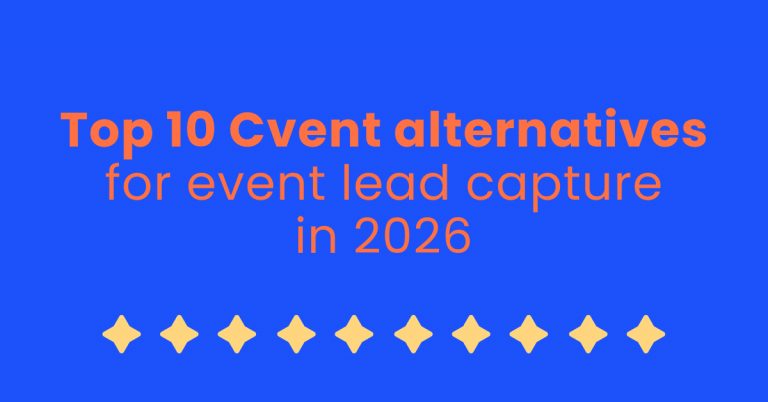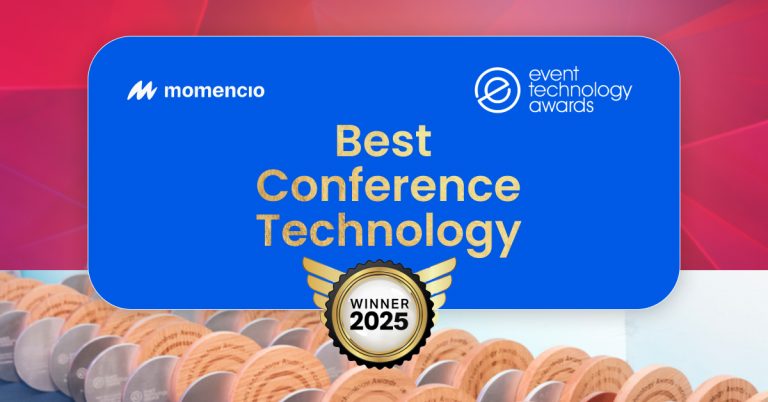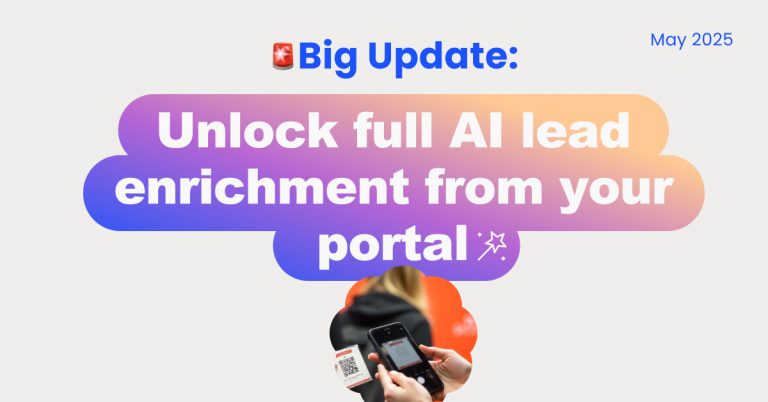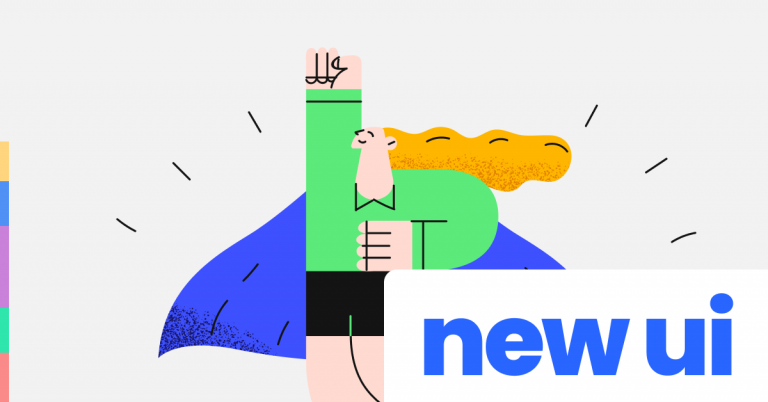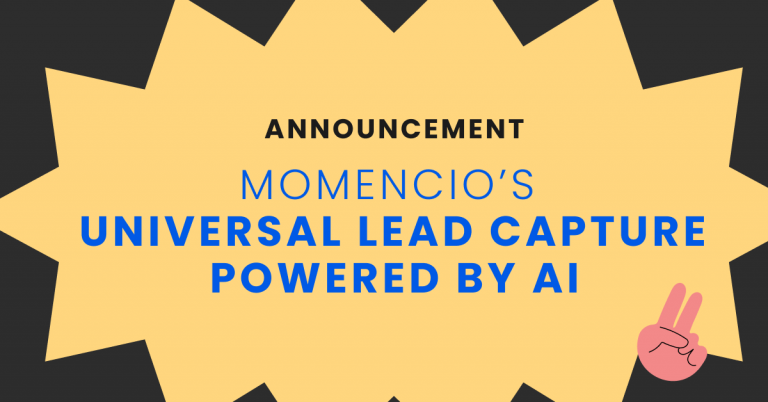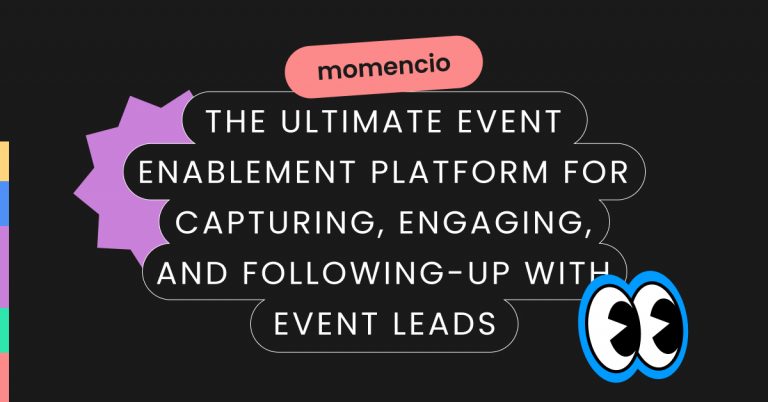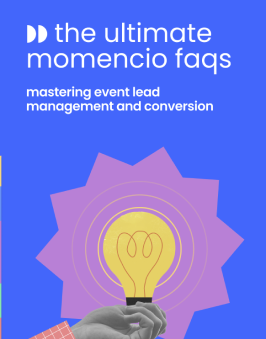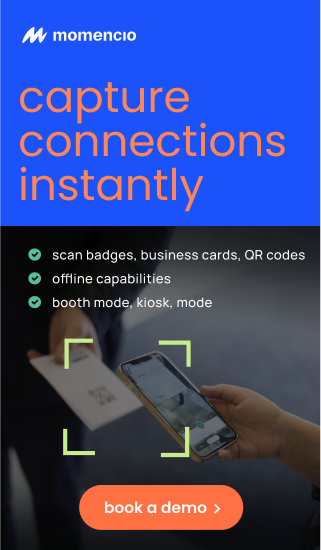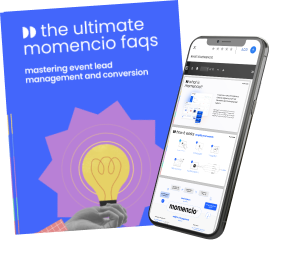Event lead retrieval is no longer just a logistical task—it’s a strategic cornerstone for maximizing event ROI and accelerating sales pipelines. With 80.4% businesses vouching for in-person events being the most impactful marketing channel, businesses are increasingly leveraging advanced technologies to ensure no opportunity slips through the cracks.
In today’s hyper-competitive landscape, an event’s success depends not only on attracting attendees but also on effectively capturing and nurturing leads after the event. Yet, studies show that 79% of marketers feel they fail to leverage post-event data, leaving potential deals on the table.
What’s the solution? Smart lead retrieval technologies and strategies that make capturing, analyzing, and acting on lead data seamless. Businesses using CRM-integrated tools report a 45% faster lead conversion rate, emphasizing the role of technology in streamlining the process.
In this article we explore five proven strategies to:
-
Capture leads quickly and accurately.
-
Improve engagement using gamification.
-
Leverage data analytics for smarter decisions.
-
Streamline follow-ups with automation.
-
Optimize CRM integrations for better lead management.
Whether you’re an event planner, marketing manager, or field marketer, this guide provides actionable insights to make your event lead retrieval process faster, more efficient, and ROI-driven.
Strategy #1: Leverage badge scanning solutions for instant lead capture
Badge scanning solutions have transformed event lead retrieval, offering instant and accurate data capture. Traditional methods, such as collecting business cards or manually entering contact details, are now considered inefficient and prone to errors. Modern badge scanning technologies eliminate these challenges by automating data collection and integrating it directly into lead management systems.
One of the key advantages of badge scanning solutions is their ability to capture leads quickly without disrupting attendee interactions. With a simple scan, exhibitors can collect contact information, job titles, and company details. This efficiency allows booth staff to focus more on engaging with visitors rather than handling paperwork.
In addition, badge scanning tools often come with customizable tagging features, enabling teams to categorize leads based on interest levels, product preferences, or meeting outcomes. This categorization helps prioritize follow-ups and ensures high-potential leads receive immediate attention.
Another benefit is real-time data access, allowing sales teams to monitor performance during the event. Exhibitors can track metrics such as the number of scans per session or peak interaction periods, helping to optimize booth strategies on the spot.
For seamless implementation, businesses should select badge scanning systems that integrate with CRM platforms and email marketing tools. This integration allows captured data to flow into automated workflows, triggering personalized follow-ups without manual intervention.
To make the most of badge scanning solutions, it’s important to train booth staff thoroughly. Teams should understand how to use the technology effectively, including tagging leads and adding quick notes about interactions. With proper training, companies can ensure that every scan translates into actionable data.
Efficient lead retrieval technology is no longer a luxury but a necessity for competitive event marketing. Businesses that adopt badge scanning solutions gain a significant edge by minimizing errors, maximizing productivity, and capturing high-quality leads for immediate follow-up.
Strategy #2: Optimize lead retrieval with CRM integrations
Optimizing event lead retrieval through CRM integrations is one of the most effective ways to streamline data management and nurture leads. By connecting lead capture tools directly with CRM platforms, businesses can eliminate manual data entry, reduce errors, and accelerate follow-up processes.
A seamless CRM integration ensures that every lead captured during an event is automatically stored in a centralized database. This eliminates the need to compile spreadsheets or transfer data manually, saving time and ensuring consistency. Once stored, leads can be segmented based on engagement levels, demographics, or interests, enabling personalized follow-ups.
CRM platforms also enhance lead scoring and prioritization. With integrated analytics, teams can identify which leads show the highest potential for conversion. Automated scoring assigns values to leads based on actions such as booth visits, session attendance, or interactions with marketing materials. This process helps sales teams focus their efforts on high-priority leads, improving efficiency and conversion rates.
In addition, CRM systems facilitate personalized communication strategies. Using pre-set workflows, businesses can send targeted follow-ups immediately after the event. These emails can include personalized content, such as product demos, case studies, or event highlights, designed to maintain interest and drive further engagement.
Another advantage is the ability to track multi-channel interactions. With CRM tools, businesses can monitor whether leads open emails, visit websites, or download resources. These insights allow marketing teams to refine their approach and tailor content to match each lead’s behavior.
For companies considering CRM integration, choosing platforms with event-specific capabilities is key. Solutions that support real-time data syncing, automated lead categorization, and customizable email templates deliver the best results. Popular options include Salesforce, HubSpot, and Marketo, all of which offer advanced features tailored for event marketing.
To ensure smooth integration, businesses should conduct pre-event testing to verify compatibility and resolve any technical issues. Training sales and marketing teams on how to navigate CRM dashboards and leverage analytics tools is equally important for maximizing results.
By integrating CRM systems with event lead retrieval tools, businesses can transform raw data into actionable insights. This approach not only simplifies post-event workflows but also helps convert leads into long-term clients through timely and personalized engagement.
Strategy #3: Use gamification to increase booth engagement
Gamification has emerged as a powerful tool to enhance event lead retrieval by making booth interactions more dynamic and memorable. By integrating game-like elements into the attendee experience, businesses can boost engagement, encourage participation, and create lasting impressions that translate into qualified leads.
Interactive games, quizzes, and contests not only draw visitors to booths but also encourage them to share contact information in exchange for participation. These activities provide an opportunity to capture detailed lead data while offering attendees a fun and engaging experience. For example, prize wheels, trivia games, and scavenger hunts can spark curiosity and excitement, driving traffic and increasing dwell time at booths.
One of the main advantages of gamification is its ability to collect behavioral insights. Attendees’ responses during quizzes or games can reveal their interests, preferences, and pain points. This information is invaluable for customizing follow-ups and prioritizing high-potential leads. Businesses can then use these insights to personalize their communication strategies and nurture leads effectively.
Gamified engagement also works exceptionally well with mobile apps and badge scanning technologies. Attendees can scan badges to unlock challenges or participate in leaderboards, seamlessly integrating entertainment with lead capture. This approach minimizes barriers to participation and streamlines data collection.
Platforms like momencio simplify the implementation of gamification by offering built-in features for interactive experiences. With momencio’s gamification tools, event marketers can create engaging quizzes, surveys, and digital games that capture leads while keeping attendees entertained. These features are designed to integrate effortlessly with CRM systems, ensuring collected data is immediately actionable.
Beyond games, features like digital surveys and polls can gather real-time feedback, helping businesses refine their messaging and booth strategies during the event. By combining engagement and data collection, gamification turns every interaction into an opportunity for lead generation.
To maximize the impact of gamification, businesses should:
- Align games with their brand messaging and product offerings.
- Offer relevant rewards that resonate with attendees, such as discounts, product demos, or exclusive content.
- Promote activities through event marketing channels to build excitement before the event.
Post-event analytics also play a critical role in evaluating the effectiveness of gamification strategies. Tools like momencio’s analytics dashboard allow businesses to review performance metrics, such as participation rates and engagement levels, helping them refine future strategies.
By leveraging gamification, businesses can transform passive booth visitors into active participants. Combining entertainment with data capture not only enhances the attendee experience but also accelerates lead generation and conversion—especially when paired with advanced platforms like momencio that simplify the entire process.
Strategy #4: Analyze lead data to improve sales conversions
Analyzing lead data effectively is the key to transforming captured contacts into qualified prospects and eventual sales. With the rise of event lead retrieval technologies, businesses can now access rich datasets that provide actionable insights into attendee behavior, preferences, and engagement levels. This data serves as the foundation for strategic decision-making and helps optimize sales conversion efforts.
The first step in leveraging lead data is real-time tracking. By using advanced event tools, businesses can monitor attendee interactions as they happen. This includes data points such as booth visits, session attendance, downloads of marketing materials, and responses to surveys or polls. Real-time analytics empower sales teams to prioritize leads based on engagement intensity, enabling faster and more targeted follow-ups.
Lead scoring and segmentation are equally critical. Modern lead retrieval systems assign scores based on predefined criteria, such as job titles, industries, and interest levels indicated during interactions. Leads can then be segmented into categories, such as “high priority,” “follow-up later,” or “information only,” streamlining workflows and ensuring resources are focused on the most promising opportunities.
Platforms like momencio enhance this process through advanced lead scoring mechanism that analyze lead behavior and generate predictive scores. These insights allow teams to tailor their messaging, ensuring each follow-up resonates with the recipient’s specific needs and interests. The integration of momencio’s CRM features further supports the process by syncing data seamlessly, making it readily available for sales and marketing teams.
Another valuable strategy is content performance analysis. By tracking which materials attendees interact with most—such as brochures, videos, or case studies—businesses can identify what resonates best with their audience. This knowledge helps refine marketing strategies and produce more compelling content for future campaigns.
Post-event reporting tools also play a pivotal role in improving conversions. Detailed reports provide metrics like total leads captured, conversion rates, and the performance of gamified activities. These reports help assess event success, highlight areas for improvement, and inform strategies for upcoming events. With tools like momencio’s analytics dashboard, businesses can generate instant reports and monitor performance across multiple events.
To fully utilize lead data, businesses should establish data hygiene practices. Ensuring the accuracy and completeness of captured information reduces errors and simplifies segmentation. Teams should also automate processes like duplicate removal and email verification to maintain a clean database.
Lastly, businesses can integrate behavioral insights into their sales strategy. For example, tracking whether a lead revisits a personalized microsite or opens a follow-up email indicates higher intent and should prompt immediate outreach. With momencio’s tracking capabilities, teams can monitor these signals and adapt their approach accordingly.
Analyzing lead data is no longer just about gathering information—it’s about using that information to drive sales. Businesses that focus on data-driven decision-making will see higher conversions, better ROI, and more effective follow-up campaigns. Tools like momencio simplify this process by providing the insights and automation needed to turn raw data into real revenue.
Strategy #5: Implement automated follow-ups for timely engagement
Timely follow-ups are often the deciding factor between a lead that converts and one that goes cold. Implementing automated follow-ups ensures consistent communication with leads after an event, keeping your brand top-of-mind while accelerating the sales process. By combining event lead retrieval with marketing automation tools, businesses can streamline workflows, personalize outreach, and improve conversion rates.
The key advantage of automation is its speed and consistency. After leads are captured, automated systems can trigger emails immediately—thanking attendees for visiting the booth, sharing product information, or providing links to downloadable resources. This quick response not only reinforces the interaction but also demonstrates attentiveness, building trust with potential clients.
Personalization is a cornerstone of effective follow-ups. Modern tools allow marketers to tailor messages based on attendee behavior, preferences, and engagement levels captured during the event. For example, leads who participated in gamified activities or downloaded specific brochures can receive emails that reference those actions. Platforms like momencio simplify this process by enabling businesses to send personalized microsites and customized content based on each lead’s profile.
Email workflows form the backbone of follow-up automation. These workflows can be structured to guide leads through a nurturing journey, starting with a warm welcome email and progressing to product demonstrations, case studies, and promotional offers. With tools like momencio, businesses can integrate these workflows directly into their CRM systems, ensuring no lead is overlooked.
Beyond email, multi-channel follow-ups can significantly boost engagement. Combining email campaigns with SMS reminders, LinkedIn connections, and retargeting ads ensures broader reach and repeated exposure. Attendees who might not respond to emails immediately are more likely to engage through alternate channels.
Timing also matters. Studies suggest follow-ups within 48 hours of an event are most effective. However, automation tools allow businesses to schedule ongoing communications, nurturing leads over weeks or even months. Automated reminders for upcoming webinars, product launches, or special promotions can sustain interest and encourage conversions long after the event concludes.
To maximize the impact of automated follow-ups, businesses should:
- Segment leads based on interest levels and engagement metrics.
- Use analytics to measure email open rates, click-throughs, and content downloads.
- Optimize messaging based on what resonates most with each audience segment.
Platforms like momencio provide dashboards that track these metrics in real time, offering insights into what works and where adjustments are needed. Teams can refine their strategies continuously, improving performance with each event.
Post-event engagement strategies can also include surveys to gather feedback, assess attendee satisfaction, and uncover additional opportunities for follow-ups. These surveys can be automated as part of the follow-up sequence, further strengthening relationships and demonstrating a commitment to customer satisfaction.
Ultimately, automated follow-ups transform raw leads into nurtured prospects by delivering relevant content at the right time. Paired with event lead retrieval tools, this approach ensures leads are never left waiting, maximizing the chances of conversion. Solutions like momencio simplify the process with built-in automation features, helping businesses capitalize on every opportunity to drive growth.
Interesting facts about event lead retrieval
Event lead retrieval has undergone significant evolution, driven by technology and changing attendee expectations. Modern solutions now offer capabilities far beyond basic contact collection, transforming events into data-driven opportunities for sales growth. Here are some interesting facts that highlight the power and potential of advanced lead retrieval methods.
1. Digital transformation has reshaped lead retrieval systems
Gone are the days of manually collecting business cards. Today, digital badge scanning and mobile apps dominate the lead retrieval landscape. These technologies allow for instant data capture, reducing errors and enabling real-time analytics. This shift has also enabled seamless integrations with CRM platforms, streamlining post-event workflows and improving conversion rates.
2. Personalization drives engagement
Studies have shown that personalized interactions significantly improve lead engagement. Event platforms now leverage AI and machine learning to tailor content and follow-ups to each attendee’s preferences. Tools like momencio allow businesses to create custom microsites and personalized emails, ensuring follow-ups resonate with prospects’ interests.
3. Real-time analytics have become a game-changer
Event marketers can now access real-time dashboards to monitor booth traffic, lead quality, and engagement metrics during events. This allows for on-the-spot adjustments to improve performance. Technologies like momencio’s event analytics enable businesses to track these interactions seamlessly, identifying patterns that inform better decision-making.
4. Gamification boosts lead capture efficiency
Interactive games and quizzes are increasingly used to attract attendees and encourage data sharing. Businesses incorporating gamified experiences see higher participation rates and longer booth visits. Platforms like momencio make it easy to integrate such features, combining entertainment with strategic data collection.
5. Follow-up timing impacts conversion rates
The timing of follow-ups can determine whether leads convert or go cold. Research indicates that 80% of sales require at least five follow-ups, yet most sales teams give up after one or two attempts. Automated tools streamline this process, ensuring consistent communication and increasing the likelihood of closing deals.
6. CRM integrations simplify lead management
With CRM integrations, event teams no longer need to spend hours entering data manually. Tools like momencio sync captured leads instantly, enabling sales teams to access information and start nurturing prospects immediately. This integration reduces the risk of data loss and ensures leads remain organized
7. Data privacy is a top priority
As events rely more heavily on data collection, compliance with privacy regulations like GDPR and CCPA has become critical. Modern lead retrieval platforms include built-in security features to protect sensitive information and ensure compliance. Businesses that prioritize data security build trust and credibility with their audiences.
8. Hybrid and virtual events are redefining lead retrieval
The rise of hybrid and virtual events has introduced new challenges and opportunities in lead retrieval. Virtual platforms now feature live polling, digital forms, and interactive sessions to capture attendee data. These insights complement traditional methods, providing a more comprehensive view of engagement.
9. AI and automation are the future
Artificial intelligence is increasingly used to score leads, predict buying behavior, and suggest follow-up actions. Platforms like momencio integrate AI-driven insights to prioritize leads and personalize communication, allowing businesses to maximize ROI with minimal effort.
10. Post-event analytics drive improvement
Event marketers now rely on post-event reporting tools to measure performance and fine-tune future strategies. Metrics like lead conversion rates, content engagement, and email click-throughs help optimize campaigns for better outcomes.
These insights highlight how event lead retrieval has evolved from a basic task into a sophisticated, data-driven process. Leveraging technologies like momencio enables businesses to capture and nurture leads more effectively, ultimately driving higher ROI and sales success.
FAQs
- What is event lead retrieval, and why is it important?
- Event lead retrieval is the process of capturing attendee information at conferences, trade shows, and other events to build a pipeline of potential sales opportunities. It is important because it streamlines data collection, reduces manual errors, and allows businesses to track and nurture leads effectively. By using modern tools such as badge scanning solutions and CRM integrations, companies can prioritize high-quality leads and improve follow-up strategies to increase sales conversions.
- How does badge scanning technology work in lead retrieval?
- Badge scanning technology uses QR codes, RFID tags, or NFC chips embedded in attendee badges to collect data quickly and accurately. Exhibitors scan badges using mobile apps or handheld devices to capture essential details such as names, contact information, and job titles. Advanced systems, including those offered by momencio, enable real-time data syncing with CRM platforms, ensuring leads are instantly organized for follow-ups. These systems also support custom tagging, which categorizes leads based on interest or interaction level, improving sales prioritization and marketing alignment.
- What features should I look for in a lead retrieval system?
- When choosing a lead retrieval system, it is essential to prioritize features that enhance efficiency and engagement. Real-time analytics allow businesses to monitor performance during events, while CRM integrations ensure seamless data transfer and follow-ups. Gamification tools can attract more leads by making booth experiences interactive and enjoyable. Custom tagging features help prioritize leads based on interest or behavior, and automated workflows simplify follow-ups by sending personalized emails immediately after the event. Platforms like momencio combine these features, providing businesses with a streamlined approach to capturing and managing leads effectively.
- How can lead retrieval tools improve post-event follow-ups?
- Lead retrieval tools improve post-event follow-ups by automating email sequences, segmenting leads based on engagement, and tracking behaviors such as email opens and clicks. Businesses can tailor messages to address specific interests or actions taken during the event, ensuring follow-ups remain relevant and impactful. Solutions like momencio go a step further by offering personalized microsites, which provide additional resources, product information, and event highlights to keep leads engaged after the event. These tools eliminate delays and ensure every lead receives timely and customized communication, boosting the chances of conversion.
- How do I measure the success of my lead retrieval efforts?
- Measuring the success of lead retrieval efforts involves tracking several key metrics. The total number of leads captured during the event provides an initial indication of performance. Evaluating lead quality based on scoring and segmentation reveals which leads are most likely to convert into sales. Monitoring engagement rates, including email opens, link clicks, and downloads, offers insights into follow-up effectiveness. Conversion rates, which reflect the percentage of leads moving through the sales funnel, demonstrate the overall impact on revenue generation. Additionally, calculating return on investment (ROI) by comparing revenue earned to the cost of attending the event helps assess profitability. Platforms like momencio simplify this process with detailed dashboards and reports, enabling businesses to refine their lead retrieval strategies for future events.
